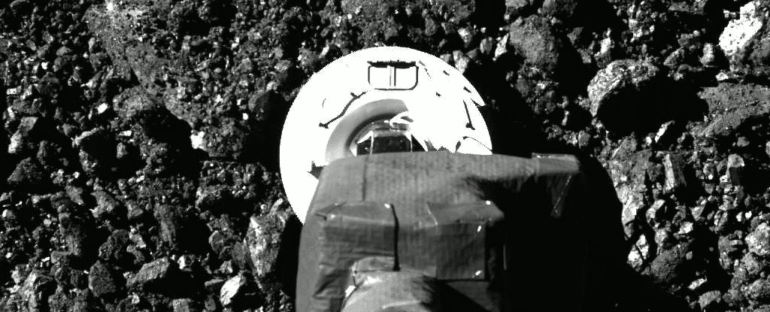Want a little reminder of how amazingly clever we humans can be? Yesterday, from a distance of more than 320 million kilometres (200 million miles) away, NASA scientists piloted a spacecraft to gently touch down on a spinning asteroid, collecting a sample of surface rubble to bring back home to Earth.
At 6:08 PM EDT, the signal from spacecraft OSIRIS-REx reached Earth to let us know that it had successfully touched down at the Nightingale collection site on asteroid Bennu, within a metre (three feet) of its target, and safely bounced back up again after just 6 seconds of contact.
During this time, the Touch-and-Go Sample Acquisition Mechanism (TAGSAM) arm hopefully collected a sizeable sample of dust and rock from the asteroid for further comprehensive study.
Yesterday, NASA’s live feed of the event showed a CG animation of the touchdown, since OSIRIS-REx’s data transfer rate is just 40 bits per second – way too low for a live video feed. But the spacecraft was photographing the process, and now those images have arrived home to be compiled into a spectacular timelapse.
The SamCam imager took a photo every 1.25 seconds, which will allow scientists back here on Earth to study the spacecraft’s performance. The above video is made up of 82 photos, covering a five-minute period from an altitude of about 25 metres (82 feet), through the touchdown, then as the spacecraft fires its thrusters to bounce away to an altitude of 13 metres (43 feet).
“Upon initial contact, the TAGSAM head appears to crush some of the porous rocks underneath it,” astronomer and OSIRIS-REx scientist Brittany Enos of the University of Arizona wrote in a NASA post.
“One second later, the spacecraft fires a nitrogen gas bottle, which mobilises a substantial amount of the sample site’s material. Preliminary data show the spacecraft spent approximately 5 of the 6 seconds of contact collecting surface material, and the majority of sample collection occurred within the first 3 seconds.”
TAGSAM is designed to collect material by stirring up material, then catching it. The team is hoping for at least 60 grams (2.1 ounces) of asteroid regolith, but we won’t know for a few days exactly how much material OSIRIS-REx managed to snare.
The returned sample, so hard won, will be invaluable. Scientists hope to use its chemical composition to inform asteroid collision avoidance strategies for Earth, and investigate the possibilities of mining asteroids.
Asteroids such as Bennu are thought to be relatively unchanged since their formation in the earliest days of the Solar System. So, the rocks and dust retrieved by OSIRIS-REx will be a rare window into the pristine chemical composition of the dust cloud that birthed the Sun and planets.
As OSIRIS-REx principal investigator Dante Lauretta of the University of Arizona noted, “This is all about understanding our origins, addressing some of the most fundamental questions that we ask ourselves as human beings: Where did we come from? And are we alone in the Universe?”
OSIRIS-REx is due to return to Earth in 2023, contributing to a small but growing pool of asteroid dust. Japan’s Hayabusa probe successfully collected and returned a sample of asteroid Itokawa to Earth in 2010.
And last year, we watched Hayabusa2 successfully collect a sample of asteroid Ryugu; it’s due to return the sample to Earth in just a few months as it flies past en route to asteroid 1998 KY26 for a 2026 rendezvous.



